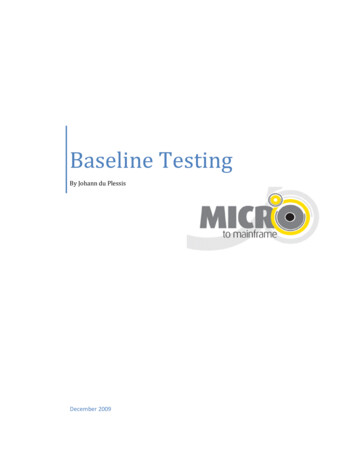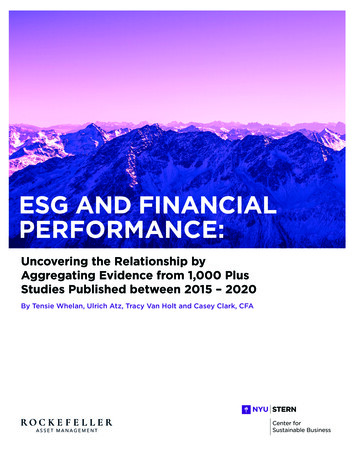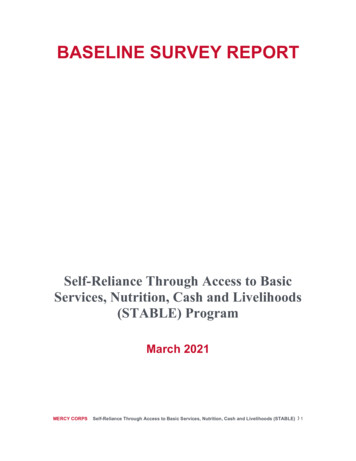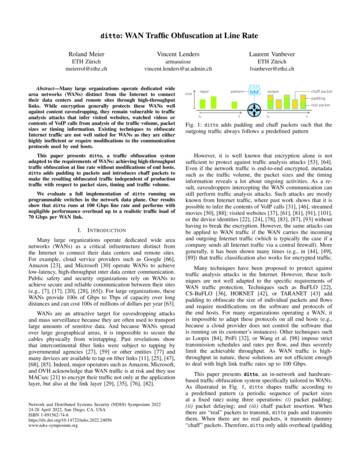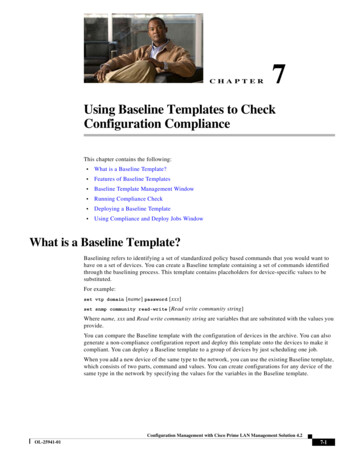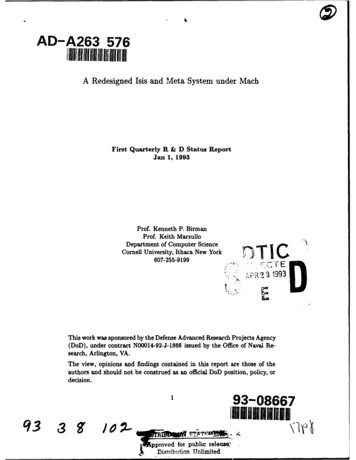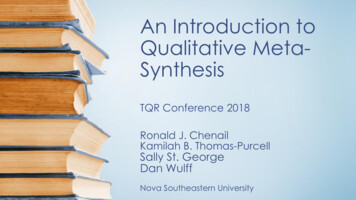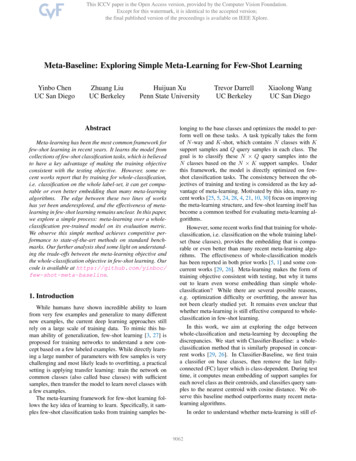
Transcription
Meta-Baseline: Exploring Simple Meta-Learning for Few-Shot LearningYinbo ChenUC San DiegoZhuang LiuUC BerkeleyHuijuan XuPenn State UniversityAbstractMeta-learning has been the most common framework forfew-shot learning in recent years. It learns the model fromcollections of few-shot classification tasks, which is believedto have a key advantage of making the training objectiveconsistent with the testing objective. However, some recent works report that by training for whole-classification,i.e. classification on the whole label-set, it can get comparable or even better embedding than many meta-learningalgorithms. The edge between these two lines of workshas yet been underexplored, and the effectiveness of metalearning in few-shot learning remains unclear. In this paper,we explore a simple process: meta-learning over a wholeclassification pre-trained model on its evaluation metric.We observe this simple method achieves competitive performance to state-of-the-art methods on standard benchmarks. Our further analysis shed some light on understanding the trade-offs between the meta-learning objective andthe whole-classification objective in few-shot learning. Ourcode is available at . IntroductionWhile humans have shown incredible ability to learnfrom very few examples and generalize to many differentnew examples, the current deep learning approaches stillrely on a large scale of training data. To mimic this human ability of generalization, few-shot learning [3, 27] isproposed for training networks to understand a new concept based on a few labeled examples. While directly learning a large number of parameters with few samples is verychallenging and most likely leads to overfitting, a practicalsetting is applying transfer learning: train the network oncommon classes (also called base classes) with sufficientsamples, then transfer the model to learn novel classes witha few examples.The meta-learning framework for few-shot learning follows the key idea of learning to learn. Specifically, it samples few-shot classification tasks from training samples be-Trevor DarrellUC BerkeleyXiaolong WangUC San Diegolonging to the base classes and optimizes the model to perform well on these tasks. A task typically takes the formof N -way and K-shot, which contains N classes with Ksupport samples and Q query samples in each class. Thegoal is to classify these N Q query samples into theN classes based on the N K support samples. Underthis framework, the model is directly optimized on fewshot classification tasks. The consistency between the objectives of training and testing is considered as the key advantage of meta-learning. Motivated by this idea, many recent works [25, 5, 24, 28, 4, 21, 10, 30] focus on improvingthe meta-learning structure, and few-shot learning itself hasbecome a common testbed for evaluating meta-learning algorithms.However, some recent works find that training for wholeclassification, i.e. classification on the whole training labelset (base classes), provides the embedding that is comparable or even better than many recent meta-learning algorithms. The effectiveness of whole-classification modelshas been reported in both prior works [5, 1] and some concurrent works [29, 26]. Meta-learning makes the form oftraining objective consistent with testing, but why it turnsout to learn even worse embedding than simple wholeclassification? While there are several possible reasons,e.g. optimization difficulty or overfitting, the answer hasnot been clearly studied yet. It remains even unclear thatwhether meta-learning is still effective compared to wholeclassification in few-shot learning.In this work, we aim at exploring the edge betweenwhole-classification and meta-learning by decoupling thediscrepancies. We start with Classifier-Baseline: a wholeclassification method that is similarly proposed in concurrent works [29, 26]. In Classifier-Baseline, we first traina classifier on base classes, then remove the last fullyconnected (FC) layer which is class-dependent. During testtime, it computes mean embedding of support samples foreach novel class as their centroids, and classifies query samples to the nearest centroid with cosine distance. We observe this baseline method outperforms many recent metalearning algorithms.In order to understand whether meta-learning is still ef-9062
fective compared to whole-classification, a natural experiment is to see what happens if we perform further metalearning over a converged Classifier-Baseline on its evaluation metric (i.e. cosine nearest-centroid). As a resultingmethod, it is similar to MatchingNet [27] or ProtoNet [23]with an additional classification pre-training stage. Weobserve that meta-learning can still improve ClassifierBaseline, and it achieves competitive performance to stateof-the-art methods on standard benchmarks. We call thissimple method Meta-Baseline. We highlight that as amethod, all the individual components of Meta-Baselinehave been proposed in prior works, but to the best of ourknowledge, it has been overlooked that none of the priorworks studies them as a whole. We further decouple thediscrepancies by evaluating on two types of generalization: base class generalization denotes performance onfew-shot classification tasks from unseen data in the baseclasses, which follows the common definition of generalization (i.e. evaluated in the training distribution); and novelclass generalization denotes performance on few-shot classification tasks from data in novel classes, which is thegoal of the few-shot learning problem. We observe that:(i) During meta-learning, improving base class generalization can lead to worse novel class generalization; (ii) Whentraining Meta-Baseline from scratch (i.e. without wholeclassification training), it achieves higher base-class generalization but much lower novel class generalization.Our observations suggest that there could be a tradeoff between the objectives of meta-learning and wholeclassification. It is likely that meta-learning learns the embedding that works better for N -way K-shot tasks, whilewhole-classification learns the embedding with strongerclass transferability. We find that the main advantageof training for whole-classification before meta-learning islikely to be improving class transferability. Our further experiments provide a potential explanation of what makesMeta-Baseline a strong baseline: by inheriting one of themost effective evaluation metrics of the whole-classificationmodel, it maximizes the reusing of the embedding withstrong class transferability. From another perspective, ourresults also rethink the comparison between meta-learningand whole-classification from the perspective of datasets.When base classes are collected to cover the distribution ofnovel classes, novel-class generalization should converge tobase-class generalization and the strength of meta-learningmay overwhelm the strength of whole-classification.In summary, our contributions are as following: We present a simple Meta-Baseline that has been overlooked in prior work. It achieves competitive performance to state-of-the-art methods on standard benchmarks and is easy to follow. We observe a trade-off between the objectives of meta-learning and whole-classification, which potentiallyexplains the success of Meta-Baseline and rethinks theeffectiveness of both objectives in few-shot learning.2. Related WorkMost recent approaches for few-shot learning follow themeta-learning framework. The various meta-learning architectures for few-shot learning can be roughly categorized into three groups. Memory-based methods [18, 14,22, 12, 13] are based on the idea to train a meta-learnerwith memory to learn novel concepts (e.g. an LSTMbased meta-learner). Optimization-based methods [6, 21]follows the idea of differentializing an optimization process over support-set within the meta-learning framework:MAML [4] finds an initialization of the neural network thatcan be adapted to any novel task using a few optimization steps. MetaOptNet [10] learns the feature representation that can generalize well for a linear support vectormachine (SVM) classifier. Besides explicitly consideringthe dynamic learning process, metric-based methods [27]meta-learn a deep representation with a metric in featurespace. For example, Prototypical Networks [23] computethe average feature for each class in support-set and classify query samples by the nearest-centroid method. Theyuse Euclidean distance since it is a Bregman divergence.Relation Networks [25] further generalizes this frameworkby proposing a relation module as a learnable metric jointlytrained with deep representations. TADAM [15] proposes touse a task conditioned metric resulting in a task-dependentmetric space.While significant progress is made in the meta-learningframework, some recent works challenge the effectivenessof meta-learning with simple whole-classification, i.e. aclassification model on the whole training label-set. Cosine classifier [5] and Baseline [1] perform wholeclassification training by replacing the top linear layer witha cosine classifier, and they adapt the classifier to a fewshot classification task of novel classes by performing nearest centroid or fine-tuning a new layer respectively. Theyshow these whole-classification models can achieve competitive performance compared to several popular metalearning models. Another recent work [2] studies on a transductive setting. Along with these baseline methods, moreadvanced meta-learning methods [24, 10, 30] are proposedand they set up new state-of-the-art results. The effectiveness of whole-classification is then revisited in two of theconcurrent works [29, 26] with improved design choices.By far, the effectiveness of meta-learning compared towhole-classification in few-shot learning is still unclear,since the edge between whole-classification models andmeta-learning models remains underexplored. The goal ofthis work is to explore the insights behind the phenomenons.Our experiments show a potential trade-off between the9063
MethodMatching Networks [27]Prototypical Networks [23]Baseline [1]Meta-Baseline (ours)Whole-classification trainingno / yes (large models)noyes (cosine classifier)yesMeta-learningattention cosinecentroid Euclideancentroid cosine ( )OthersFCEfine-tuning-Table 1: Overview of method comparison. We summarize the differences between Meta-Baseline and prior methods.meta-learning and whole-classification objectives, whichprovides a more clear understanding of the comparison between both objectives for few-shot learning.As a method, similar ideas to Classifier-Baseline are concurrently reported in recent works [29, 26]. Unlike someprior works [5, 1], Classifier-Baseline does not replace thelast layer with cosine classifier during training, it trainsthe whole-classification model with a linear layer on thetop and applies cosine nearest-centroid metric during thetest time for few-shot classification on novel classes. TheMeta-Baseline is meta-learning over a converged ClassifierBaseline on its evaluation metric (cosine nearest-centroid).It is similar (with inconspicuous and important differencesas shown in Table 1) to those simple and classical metricbased meta-learning methods [27, 23]. The main purpose ofMeta-Baseline in this paper is to understand the comparisonbetween whole-classification and meta-learning objectives,but we find it is also a simple meta-learning baseline thathas been overlooked. While every individual component inMeta-Baseline is not novel, to the best of our knowledge,none of the prior works studies them as a whole.support-set S, let Sc denote the few-shot samples in classc, it computes the average embedding wc as the centroid ofclass c:1 Xwc f (x),(1) Sc x2Scthen for a query sample x in a few-shot task, it predicts theprobability that sample x belongs to class c according to thecosine similarity between the embedding of sample x andthe centroid of class c:p(y c x) Pexp hf (x), wc i,0c0 exp hf (x), wc i(2)3. Methodwhere h·, ·i denotes the cosine similarity of two vectors.Similar methods to Classifier-Baseline have also beenproposed in concurrent works [29, 26]. Compared to Baseline [1], the Classifier-Baseline does not use the cosineclassifier for training or perform fine-tuning during testing,while it performs better on standard benchmarks. In thiswork, we choose Classifier-Baseline as the representative ofwhole-classification models for few-shot learning. For simplicity and clarity, we do not introduce additional complextechniques for this whole-classification training.3.1. Problem definition3.3. Meta-BaselineIn standard few-shot classification, given a labeleddataset of base classes Cbase with a large number of images, the goal is to learn concepts in novel classes Cnovelwith a few samples. In an N -way K-shot few-shot classification task, the support-set contains N classes with Ksamples per class, the query-set contains samples from thesame N classes with Q samples per class, and the goal is toclassify the N Q query images into N classes.Figure 1 visualizes the Meta-Baseline. The first stageis the classification training stage, it trains a ClassifierBaseline, i.e. training a classifier on all bases classes andremove its last FC layer to get f . The second stage is themeta-learning stage, which optimizes the model on the evaluation metric of Classifier-Baseline. Specifically, given theclassification-trained feature encoder f , it samples N -wayK-shot tasks (with N Q query samples) from trainingsamples in base classes. To compute the loss for each task,in support-set it computes the centroids of N classes defined in Equation 1, which are then used to compute thepredicted probability distribution for each sample in queryset defined in Equation 2. The loss is a cross-entropy losscomputed from p and the labels of the samples in the queryset. During training, each training batch can contain severaltasks and the average loss is computed.Since cosine similarity has the value range of [ 1, 1],when it is used to compute the logits, it can be helpful to3.2. Classifier-BaselineClassifier-Baseline is a whole-classification model, i.e.a classification model trained for the whole label-set. Itrefers to training a classifier with classification loss on allbase classes and performing few-shot tasks with the cosinenearest-centroid method. Specifically, we train a classifieron all base classes with standard cross-entropy loss, then remove its last FC layer and get the encoder f , which mapsthe input to embedding. Given a few-shot task with the9064
Classification Training onon base classesMeta-Learning StagerepresentationtransferClassifier-Baseline / ure 1: Classifier-Baseline and Meta-Baseline. Classifier-Baseline is to train a classification model on all base classesand remove its last FC layer to get the encoder f . Given a few-shot task, it computes the average feature for samples of eachclass in support-set, then it classifies a sample in query-set by nearest-centroid with cosine similarity as distance. In MetaBaseline, it further optimizes a converged Classifier-Baseline on its evaluation metric, and an additional learnable scalar isintroduced to scale cosine similarity.scale the value before applying Softmax function duringtraining (a common practice in recent work [5, 16, 15]). Wemultiply the cosine similarity by a learnable scalar , andthe probability prediction in training becomes:p(y c x) Pexp · hf (x), wc i.0c0 exp · hf (x), wc i(3)In this work, the main purpose of Meta-Baseline is toinvestigate whether the meta-learning objective is still effective over a whole-classification model. As a method,while every component in Meta-Baseline has been proposedin prior works, we find none of the prior works studies themas a whole. Therefore, Meta-Baseline should also be an important baseline that has been overlooked.4. Results on Standard Benchmarks4.1. DatasetsThe miniImageNet dataset [27] is a common benchmarkfor few-shot learning. It contains 100 classes sampled fromILSVRC-2012 [20], which are then randomly split to 64,16, 20 classes as training, validation, and testing set respectively. Each class contains 600 images of size 84 84.The tieredImageNet dataset [19] is another commonbenchmark proposed more recently with much larger scale.It is a subset of ILSVRC-2012, containing 608 classes from34 super-categories, which are then split into 20, 6, 8 supercategories, resulting in 351, 97, 160 classes as training, validation, testing set respectively. The image size is 84 84.This setting is more challenging since base classes andnovel classes come from different super-categories.In addition to the datasets above, we evaluate our modelon ImageNet-800, which is derived from ILSVRC-2012 1Kclasses by randomly splitting 800 classes as base classesand 200 classes as novel classes. The base classes containthe images from the original training set, the novel classescontain the images from the original validation set. Thislarger dataset aims at making the training setting standardas the ImageNet 1K classification task [7].4.2. Implementation detailsWe use ResNet-12 that follows the most of recentworks [15, 24, 10, 30] on miniImageNet and tieredImageNet, and we use ResNet-18, ResNet-50 [7] on ImageNet800. For the classification training stage, we use the SGDoptimizer with momentum 0.9, the learning rate starts from0.1 and the decay factor is 0.1. On miniImageNet, we train100 epochs with batch size 128 on 4 GPUs, the learningrate decays at epoch 90. On tieredImageNet, we train 120epochs with batch size 512 on 4 GPUs, the learning rate de-9065
ModelBackboneMatching Networks [27]Prototypical Networks [23]Prototypical Networks (re-implement)Activation to Parameter [17]LEO [21]Baseline [1]SNAIL [12]AdaResNet [14]TADAM [15]MTL [24]MetaOptNet [10]SLA-AG [9]ProtoNets TRAML [11]ConstellationNet -12ResNet-12ResNet-12ResNet-12Classifier-Baseline (ours)Meta-Baseline (ours)ResNet-12ResNet-121-shot5-shot43.56 0.8448.70 1.8453.81 0.2359.60 0.4161.76 0.0851.87 0.7755.71 0.9956.88 0.6258.50 0.3061.20 1.8062.64 0.6162.93 0.6360.31 0.4864.89 0.2355.31 0.7363.11 0.9275.68 0.1773.74 0.1977.59 0.1275.68 0.6368.88 0.9271.94 0.5776.70 0.3075.50 0.8078.63 0.4679.63 0.4777.94 0.5779.95 0.1758.91 0.2363.17 0.2377.76 0.1779.26 0.17Table 2: Comparison to prior works on miniImageNet. Average 5-way accuracy (%) with 95% confidence interval.ModelBackboneMAML [4]Prototypical Networks* [23]Relation Networks* [25]LEO [21]MetaOptNet lassifier-Baseline (ours)Meta-Baseline (ours)ResNet-12ResNet-121-shot5-shot51.67 1.8153.31 0.8954.48 0.9366.33 0.0565.99 0.7270.30 1.7572.69 0.7471.32 0.7881.44 0.0981.56 0.5368.07 0.2668.62 0.2783.74 0.1883.74 0.18Table 3: Comparison to prior works on tieredImageNet. Average 5-way accuracy (%) with 95% confidence interval.cays at epoch 40 and 80. On ImageNet-800, we train 90epochs with batch size 256 on 8 GPUs, the learning rate decays at epoch 30 and 60. The weight decay is 0.0005 forResNet-12 and 0.0001 for ResNet-18 or ResNet-50. Standard data augmentation is applied, including random resized crop and horizontal flip. For meta-learning stage, weuse the SGD optimizer with momentum 0.9. The learningrate is fixed as 0.001. The batch size is 4, i.e. each trainingbatch contains 4 few-shot tasks to compute the average loss.The cosine scaling parameter is initialized as 10.We also apply consistent sampling for evaluating the performance. For the novel class split in a dataset, the samplingof testing few-shot tasks follows a deterministic order. Consistent sampling allows us to get a better model comparisonwith the same number of sampled tasks. In the followingsections, when the confidence interval is omitted in the table, it indicates that a fixed set of 800 testing tasks are sam-pled for estimating the performance.4.3. ResultsFollowing the standard-setting, we conduct experimentson miniImageNet and tieredImageNet, the results are shownin Table 2 and 3 respectively. To get a fair comparison toprior works, we perform model selection according to thevalidation set. On both datasets, we observe that the MetaBaseline achieves competitive performance to state-of-theart methods. We highlight that many methods for comparison introduce more parameters and architecture designs(e.g. self-attention in [30]), while Meta-Baseline has theminimum parameters and the simplest design. We also notice that the simple Classifier-Baseline can achieve competitive performance when compared to meta-learning methods, especially in 5-shot tasks. We observe that the metalearning stage consistently improves Classifier-Baseline on9066
ModelBackbone1-shot5-shotClassifier-Baseline (ours)Meta-Baseline (ours)ResNet-18ResNet-18Classifier-Baseline (ours)Meta-Baseline (ours)ResNet-50ResNet-5083.51 0.2286.39 0.2294.82 0.1094.82 0.1086.07 0.2189.70 0.1996.14 0.0896.14 0.08Table 4: Results on ImageNet-800. Average 5-way accuracy (%) is reported with 95% confidence interval.Figure 2: Objective discrepancy of meta-learning on miniImageNet and tieredImageNet. Each epoch contains 200training batches. Average 5-way accuracy (%) is reported.5. Observations and Hypothesis5.1. Objective discrepancy in meta-learningFigure 3: Objective discrepancy of meta-learning onImageNet-800. Each epoch contains 500 training batches.Average 5-way accuracy (%) is reported.miniImageNet. Compared to miniImageNet, we find thatthe gap between Meta-Baseline and Classifier-Baseline issmaller on tieredImageNet, and the meta-learning stagedoes not improve 5-shot in this case.We further evaluate our methods on the larger datasetImageNet-800. In this larger-scale experiment, we findfreezing the Batch Normalization layer [8] (set to evalmode) is beneficial. The results are shown in Table 4.From the results, we observe that in this large dataset MetaBaseline improves Classifier-Baseline in 1-shot, while it isnot improving the performance in 5-shot.Despite the improvements of meta-learning overClassifier-Baseline, we observe the test performance dropsduring the meta-learning stage. While a common assumption for this phenomenon is overfitting, we observe that thisissue seems not to be mitigated on larger datasets. To furtherlocate the issue, we propose to evaluate base class generalization and novel class generalization. Base class generalization is measured by sampling tasks from unseen imagesin base classes, while novel class generalization refers to theperformance of few-shot tasks sampled from novel classes.The base class generalization is the generalization in the input distribution for which the model is trained, it decouplesthe commonly defined generalization and class-level transfer performance, which helps for locating the reason for theperformance drop.Figure 2 and 3 demonstrate the meta-learning stage ofMeta-Baseline on different datasets. We find that during themeta-learning stage, when the base class generalization isincreasing, the novel class generalization can be decreasinginstead. This fact indicates that over a converged wholeclassification model, the meta-learning objective itself, i.e.making the embedding generalize better in few-shot tasksfrom base classes, can have a negative effect on the performance of few-shot tasks from novel classes. It also gives a9067
58.44 1.5361.6465.88 4.2468.7669.52 0.7677.6780.48 63 0.3379.2680.58 1.3284.0784.07 0.0090.5890.67 0.09Table 5: Effect of dataset properties. Average 5-way accuracy (%), with ResNet-12.TrainingBase gen.Novel gen.1-shotw/ ClsTrw/o ClsTr86.4286.7463.3358.545-shotw/ ClsTrw/o ClsTr93.5494.4780.0274.95Table 6: Comparison on Meta-Baseline training fromscratch. Average 5-way accuracy (%), with ResNet-12 onminiImageNet. ClsTr: classification training stage.possible explanation for why such phenomenon is not mitigated on larger datasets, as this is not sample-level overfitting, but class-level overfitting, which is caused by theobjective discrepancy that the underlying training class distribution is different from testing class distribution.This observation suggests that we may reconsider themotivation of the meta-learning framework for few-shotlearning. In some settings, optimizing towards the training objective with a consistent form as the testing objective(except the inevitable class difference) may have an evennegative effect. It is also likely that the whole-classificationlearns the embedding with stronger class transferability, andmeta-learning makes the model perform better at N -wayK-shot tasks but tends to lose the class transferability.5.2. Effect of whole-classification training beforemeta-learningAccording to our hypothesis, the whole-classificationpre-trained model has provided extra class transferability for the meta-learning model, therefore, it is natural tocompare Meta-Baseline with and without the classificationtraining stage. The results are shown in Table 6. We observethat Meta-Baseline trained without classification trainingstage can actually achieve higher base class generalization,but its novel class generalization is much lower when compared to Meta-Baseline with whole-classification training.These results support our hypothesis, that the wholeclassification training provides the embedding with strongerclass transferability, which significantly helps novel classgeneralization. Interestingly, TADAM [15] finds thatco-training the meta-learning objective with a ier-Baseline ne (Euc.)63.3360.1980.0279.50Table 7: Importance of inheriting a good metric. Average 5-way accuracy (%), with ResNet-12 on miniImageNet.classification task is beneficial, which may be potentiallyrelated to our hypothesis. While our results show it is likelythat the key effect of the whole-classification objective isimproving the class transferability, it also indicates a potential trade-off that the whole-classification objective canhave a negative effect on base class generalization.5.3. What makes Meta-Baseline a strong baseline?As a method with a similar objective as ProtoNet [23],Meta-Baseline achieves nearly 10% higher accuracy on 1shot in Table 2. The observations and hypothesis in previous sections potentially explain its strength, as it starts withthe embedding of a whole-classification model which hasstronger class transferability.We perform further experiments, that in Meta-Baseline(with classification training stage) we replace the cosinedistance with the squared Euclidean distance proposed inProtoNet [23]. To get a fair comparison, we also includethe learnable scalar with a proper initialization value 0.1.The results are shown in Table 7. While ProtoNet [23]finds that squared Euclidean distance (as a Bregman divergence) works better than cosine distance when performing meta-learning from scratch, here we start meta-learningfrom Classifier-Baseline and we observe that cosine similarity works much better. A potential reason is that, asshown in Table 7, cosine nearest-centroid works much better than nearest-centroid with squared Euclidean distance inClassifier-Baseline (note that this is just the evaluation metric and has no changes in training). Inheriting a good metricfor Classifier-Baseline might be the key that makes MetaBaseline strong. According to our hypothesis, the embed-9068
ding from the whole-classification model has strong classtransferability, inheriting a good metric potentially minimizes the future modifications on the embedding from thewhole-classification model, thus it can keep the class transferability better and achieve higher performance.5.4. Effect of dataset propertiesWe construct four variants from the tieredImageNetdataset. Specifically, full-tiered refers to the original tieredImageNet, full-shuffled is constructed by randomly shuffling the classes in tieredImageNet and re-splitting theclasses into training, validation, and test set. The minitiered and mini-shuffled datasets are constructed from fulltiered and full-shuffled respectively, their training set is constructed by randomly selecting 64 classes with 600 imagesfrom each class in the full training set, while the validationset and the test set remain unchanged. Since tieredImageNetseparates training classes and testing classes into differentsuper categories, shuffling these classes will mix the classesin different super categories together and make the distribution of base classes and novel classes closer.Our previous experiments show that base class generalization is always improving, if novel classes are coveredby the distribution of base classes, the novel class generalization should also keep increasing. From Table 5, wecan see that from mini-tiered to mini-shuffled, and fromfull-tiered to full-shuffled, the improvement achieved by themeta-learning stage gets significantly larger, which consistently supports our hypothesis. Therefore, our results indicate it is likely that meta-learning is mostly effective overwhole-classification training when novel classes are similarto base classes.We also observe that other factors may affect the improvement of meta-learning. From mini-tiered to full-tieredand from mini-shuffled to full-shuffled, when the datasetgets larger the improvements become less. A potential hypo
Meta-Baseline (ours) yes centroid cosine ( )-Table 1: Overview of method comparison. We summarize the differences between Meta-Baseline and prior methods. meta-learning and whole-classification objectives, which provides a more clear understanding of the comparison be-tween both objectives for few-shot learning.

